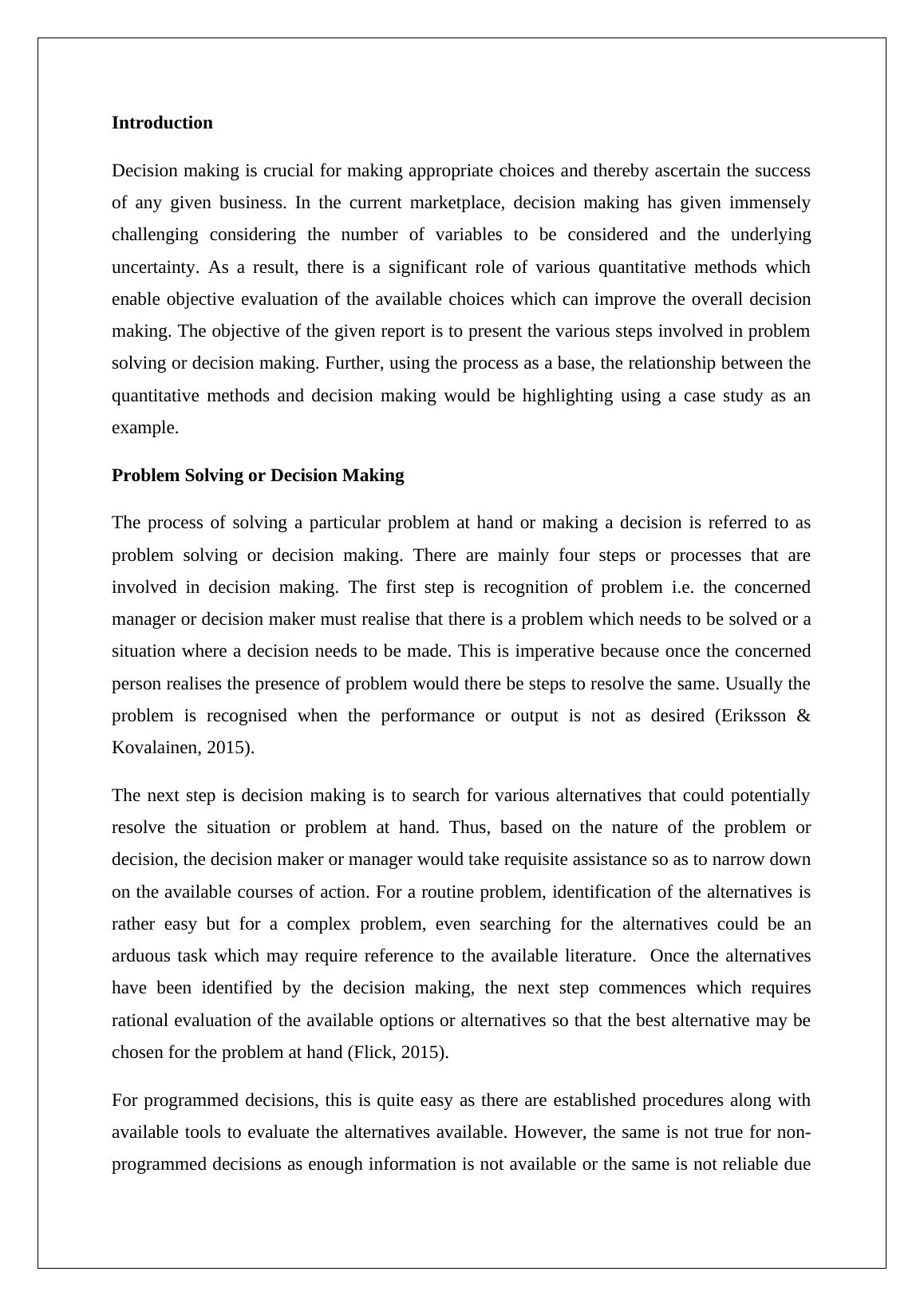Quantitative Methods in Decision Making
Added on 2020-04-15
6 Pages1505 Words87 Views
QUANTITATIVEMETHODSSTUDENT ID:[Pick the date]

IntroductionDecision making is crucial for making appropriate choices and thereby ascertain the successof any given business. In the current marketplace, decision making has given immenselychallenging considering the number of variables to be considered and the underlyinguncertainty. As a result, there is a significant role of various quantitative methods whichenable objective evaluation of the available choices which can improve the overall decisionmaking. The objective of the given report is to present the various steps involved in problemsolving or decision making. Further, using the process as a base, the relationship between thequantitative methods and decision making would be highlighting using a case study as anexample.Problem Solving or Decision MakingThe process of solving a particular problem at hand or making a decision is referred to asproblem solving or decision making. There are mainly four steps or processes that areinvolved in decision making. The first step is recognition of problem i.e. the concernedmanager or decision maker must realise that there is a problem which needs to be solved or asituation where a decision needs to be made. This is imperative because once the concernedperson realises the presence of problem would there be steps to resolve the same. Usually theproblem is recognised when the performance or output is not as desired (Eriksson &Kovalainen, 2015).The next step is decision making is to search for various alternatives that could potentiallyresolve the situation or problem at hand. Thus, based on the nature of the problem ordecision, the decision maker or manager would take requisite assistance so as to narrow downon the available courses of action. For a routine problem, identification of the alternatives israther easy but for a complex problem, even searching for the alternatives could be anarduous task which may require reference to the available literature. Once the alternativeshave been identified by the decision making, the next step commences which requiresrational evaluation of the available options or alternatives so that the best alternative may bechosen for the problem at hand (Flick, 2015).For programmed decisions, this is quite easy as there are established procedures along withavailable tools to evaluate the alternatives available. However, the same is not true for non-programmed decisions as enough information is not available or the same is not reliable due

to which rational decision making or evaluation is hampered. Once the evaluation ofalternatives is done, then a decision is taken and implementation is done. This usuallyinvolves putting the decision taken into implementation. This is followed by feedback so asto ensure that the desired output or outcome is achieved failing which rectification needs tobe done (Hair et. al., 2015).Quantitative MethodsQuantitative methods may be defined as those computation techniques which tend toemphasize on data collection through various means and carrying out the numerical orstatistical analysis of the same. These methods are critical for taking sound managerialdecisions. This is primarily because the results obtained from these methods are objective andreliable. Further, the quantitative methods if implemented appropriately could potentiallyimprove the quality of the managerial decisions made as they would be more rationalconsidering the availability of strong evidence in the form of numerical analysis. Thequantitative methods tend to identify the various relationships that tend to exist between thevarious variables present in the available data and thereby enable the decision maker to basethe decision based on these underlying patterns. Examples of quantitative methods tend toinclude various statistical techniques such as hypothesis testing, regression analysis,correlation analysis and other descriptive statistical techniques (Hillier, 2006).Relationship between quantitative methods and decision makingOne of the key steps which is involved in the decision making process is the evaluation ofalternatives. In this process, the various quantitative methods are quite useful. This is becausethey enable the decision maker to recognise patterns of association and relationship betweenthe variables of interest and hence provide useful information in the form of expectedoutcome provided a given decision is taken. A case in point could relate to whether anincremental expenditure on advertisement must be done or not. In order to evaluate theproposal, the impact of advertisement on sales needs to be understood using the historicaldata through the usage of correlation or regression analysis. This would allow the decisionmaker to work out whether the respective benefit likely to arise in the form of sales wouldoutweigh the expected incremental cost (Hastie, Tibshirani & Friedman, 2011).While the above is relatively a straight forward example, the quantitative methods could beused for more complex analysis particularly for estimating the likely scenarios and the

End of preview
Want to access all the pages? Upload your documents or become a member.
Related Documents
Evaluation and the Policy-Making Processlg...
|8
|2025
|43
Professional Proofreading Assignmentlg...
|7
|1915
|160
HRM Problem Solving Techniqueslg...
|11
|724
|42
Understanding Consumer Behavior Question Answer 2022lg...
|6
|796
|31
Marketing Principles - Assignment Samplelg...
|5
|1067
|19
Human Resource Management in Canadalg...
|7
|1283
|499
